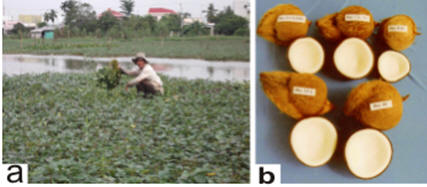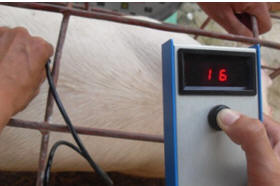 |
| Photo 2: Water spinach (a) and coconut kernel (b) |
|
Live stock production, climate change and resource depletion |
The trial was carried out on 24 growing pigs of crossbred Yorkshire x Ba Xuyen type, a breed that has adapted well in the rural areas of the Mekong Delta. The experimental pigs were equal numbers of females and castrated males, with an average initial live weight of 47.0 kg and mean final weight of 85.5 kg. The design was 3 dietary treatments. The control diet was based on rice bran, broken rice, catfish residue meal (CRM) and fresh water spinach. The experimental treatments had 25% or 50% of the protein of CRM replaced by coconut meal (CM25 or CM50).
The average daily weight gain and feed conversion ratio were improved by the CM25 treatment in comparison to the control diet. The carcass back fat thickness was not affected by dietary treatments. However, the iodine index value was reduced by incorporation of CM in the diets as the combination of catfish residue meal and coconut meal resulted in firmer fat than when only catfish meal was used. Feed cost per kg weight gain and feed benefit were lower for CM50 than for other diets.
It is concluded that combined usage of two agro industrial by-products as supplements in pig diets can improve quality of the carcass to get more benefit for the farmer.
Pig production is an important income generating activity among farm holders in the Mekong Delta, which is one of the two granaries of Vietnam. The rice by-products common is the rice bran has been used as a traditional basal feed of pigs. One common kind of water plant such as water spinach (Ipomoea aquatica) can be also used as pig feed. In contrast, commercial protein concentrates are used as a protein supplement, but the high additional costs of concentrate feed often become a financial burden for the farmers. There are also available protein-rich agro-industrial by-products such as catfish residue meal and coconut meal which need to be researched as potential replacement for protein concentrates.
Hau Giang is one province of the Mekong Delta with intensive farming systems, including paddy rice, fruits, animals and fish, which are well developed in the province (Sanh et al 1998), and the two types of catfish cultivation, both in ponds and in floating cages, are prevalent. Large factories produce aqua-cultural products for export such as Pangasius filet. The abundant residues and the whole small fish are processed to give raw catfish meal, containing crude protein level of 53% with high lysine level of 4.5%, and EE of 20% in dry matter (Le Thi Men et al 2005). This source of protein and energy supplement can be applied in animal feeding (Gohl 1981, McDonald et al 1995, Le Thi Men et al 2003, 2005), especially in pig production in the Mekong Delta.
Coconut (Cocos nucifera) is one of the most prevalent fruits in the region, while its oil is an important industrial by-product mostly used as a component of vegetable cooking oils. The semi-industrial by-product, the residue after the oil extraction is known as coconut meal. It has a crude protein (CP) content of over 22.0 % and EE equal 6.7 % (on DM basis). It also has a high proportion of poly saturated fatty acid (PFA, 93 %), dominantly lauric acid (C12:0 = 48.8 %) in total lipids that can give firmer fat deposition of fattening pigs (Le Thi Men et al 2007).
These were:
Coconut meal can replace a part of the protein of fish meal in a diet for fattening pigs without affecting the pig growth performance and with economic benefit to producers.
Opposite characteristics of oils in coconut meal (C12:0) and catfish residue meal (C18:1) can lead to fat deposition in pigs adapted to the consumer demand.
The 24 Yorkshire-Ba Xuyen type pigs comprising equal numbers of castrated males and females had 47.0 ± 1.6 kg for mean initial live weights. The design was conducted with 3 dietary treatments. The control diet was based on rice bran, water spinach and catfish residue meal (CRM). The experimental treatments based on the same ingredients but with 25 % and 50% protein of CRM replaced by coconut meal (CM), respectively (Photos 2a,b). The pigs were fed 3 times per day, and daily amounts of feed according to 3.5 % of body weight and dietary treatments. There was free access to drinking water.
 |
| Photo 2: Water spinach (a) and coconut kernel (b) |
Samples of each feedstuff were taken, and the contents of DM, CP, CF, EE were analyzed according to AOAC (2000) and fatty acids according to Jacobs et al (2000); ME was estimated according to the National Institute of Animal Husbandry (1995). All pigs were weighed at the initial and final time point of the trial. Feed refusal in every pen was collected every day.
Parameters measured were: daily weight gain, feed intake and FCR during period; back fat thickness at two opposite points, 6 cm apart from the midline, at the 10-12th ribs was estimated by using ultrasonic equipment (RENCO Co., Ltd., USA) at the time of measurement of final live weight (Photo 3). Carcass quality was determined as the iodine index of backfat extracted by the Wijs method using iodine monochloride (Pham Van So and Bui Thi Nhu Thuan 1991) and as the fatty acid content. Samples of fresh loin muscle were taken for chemical analysis of the pH, DM and CP. Cost performance (feed cost per kg weight gain) and economical benefit were also calculated.
 |
|
Photo 3: Measuring backfat thickness of pig
|
Data were analyzed by ANOVA using the Basic statistics and General Linear Model of Minitab Statistical Software version 13. Sources of variation were treatments and eror. The Tukey test for paired comparisons was used to separate means when the differences were significant at the 5% level.
Chemical compositions of the feedstuffs used in the trial (Table 1) and the experimental diets are shown in Table 2.
|
Table 1: Analyzed chemical compositions of the feedstuffs used in the experiment |
||||||||||
|
Feedstuffs |
DM, % |
% DM basis |
||||||||
|
CP |
EE |
CF |
Ash |
ME, Kcal/kg |
||||||
|
Rice bran |
89.6±0.31 |
12.6±0.21 |
10.0±0.59 |
5.5±0.23 |
9.3±0.12 |
2,844 |
||||
|
Catfish residue meal |
92.2±0.53 |
55.6±0.50 |
15.2±1.23 |
0.6±0.21 |
15.8±0.72 |
3,806 |
||||
|
Coconut meal |
94.9±0.06 |
22.2±0.10 |
9.0±0.38 |
5.1±0.25 |
7.0±0.24 |
2,939 |
||||
|
Water spinach |
8.5±0.11 |
22.7±0.37 |
4.8±0.22 |
11.9±0.23 |
10.9±0.28 |
2,700 |
||||
|
Table 2: Ingredients and feed costs of experimental diets for fattening pigs (in DM basis) |
||||||||||
|
|
Diets |
|||||||||
|
CM0 |
CM25 |
CM50 |
||||||||
|
Ingredients, % |
|
|
|
|||||||
|
Rice bran |
75 |
70 |
66 |
|||||||
|
Catfish residue meal |
15 |
11 |
8 |
|||||||
|
Coconut meal |
0 |
9 |
16 |
|||||||
|
Water spinach |
10 |
10 |
10 |
|||||||
|
Total |
100 |
100 |
100 |
|||||||
|
Feed cost, VND/kg1) |
5,682 |
5,173 |
4,791 |
|||||||
|
1)Prices per kg for rice bran: 4,500; CRM: 15,000; CM: 3,500 and WS: 3,2000 VND in DM |
||||||||||
Growth performance and feed conversion ratio were better in CM diets compared with the control. Feed cost per kg weight gain (VND) were reduced on the CM50 and CM25 diets (Table 3).
|
Table 3: Effect of experimental diets on growth performance of pigs |
|||||
|
Items |
Diets |
SE |
P |
||
|
CM0 |
CM25 |
CM50 |
|||
|
Daily gain, g/d |
575ª |
637b |
587ab |
13.203 |
0.034 |
|
Feed intake (in DM), kg/d |
1.74 |
1.83 |
1.76 |
0.025 |
0.083 |
|
CP, g/d |
311 |
315 |
293 |
4.583 |
0.094 |
|
EE, g/d |
161 |
168 |
153 |
1.996 |
0.063 |
|
CF, g/d |
89 |
97 |
99 |
0.825 |
0.085 |
|
FCR |
3.17a |
3.01b |
3.15ab |
0.040 |
0.036 |
|
Feed cost/kg gain , VND |
18,000 |
15,500 |
15,000 |
|
|
|
% Relative |
100 |
86 |
84 |
|
|
Carcass backfat thickness was not affected by dietary treatments. However, the iodine index value of backfat was reduced by incorporation of CM in the diets. The combination of catfish residue meal and coconut meal resulted in firmer fat than when only catfish meal was used according to the presence of saturated fatty acids (C12:0 and C14:0) in the lipid. In the carcass traits, pH value of the loin meat did not differ between the dietary treatments. By contrast, the contents (% in fresh basis) of DM and CP in loin meat were higher in the CM0 and CM25 compared to CM50 diet.
|
Table 4: Effect of experimental diets on the quality of finishing pig products |
|||||
|
Items |
Diets |
SE |
P |
||
|
CM0 |
CM25 |
CM50 |
|||
|
Backfat thickness (mm): |
15.7 |
16.8 |
16.2 |
0.866 |
0.693 |
|
Iodine value of backfat |
53.7ª |
51.5b |
48.9c |
0.494 |
0.001 |
|
C12:0 in fat (% lipid) |
0.16ª |
0.50b |
0.78b |
0.052 |
0.027 |
|
C14:0 in fat (% lipid) |
1.38ª |
2.09b |
2.62b |
0.080 |
0.016 |
|
Loin meat (fresh): |
|
|
|
|
|
|
pH |
5.5 |
5.8 |
5.5 |
0.100 |
0.174 |
|
DM, % |
25.9ª |
25.7ab |
25.4b |
0.111 |
0.011 |
|
CP, % |
21.6ª |
21.4ª |
20.7b |
0.089 |
0.001 |
Conclusions
AOAC 2000 Official Methods of Analysis. American Association of Analytical Chemists. Washington, DC., USA.
Göhl B 1981 Tropical Feeds. FAO Animal Production and Health Series. No. 12, pp 320-322.
Jacobs Maes P A and Peeters C 2000 Analytische en organische chemie: practicum Katholieke universiteit Leuven, pp 81-86.
Le Thi Men, Huynh Huu Chi, Ngo Vi Nghia, Nguyen Thi Kim Khang, Ogle B and Preston T R 2003: Utilization of catfish oil in diets based on dried cassava root waste for crossbred fattening pigs in the Mekong delta of Vietnam. Livestock Research for Rural Development (15) 4. http://www.lrrd.org/lrrd15/4/men154.htm
Le Thi Men, Preston T R, Truong Van Hieu, Duong T Ngan and Huynh Thu Loan 2005 Evaluation of the Tra (Pangasius hypothalamus) catfish residue meal to replace fish meal in diets for fattening pigs in the Mekong delta of Vietnam. Proceeding in Regional seminar-workshop on livestock-based sustainable farming systems in the Lower Mekong Basin. Cantho University, VN. May 23-25, 2005.
Le Thi Men, T R Preston, Tran Thi Thao, Bui Van Cong and Dang Ngoc Hoi 2005 On-farm evaluation of the effect of different fertilizers on water spinach (Ipomoea aquatica) yields, and of including water spinach and catfish oil in diets for fattening pigs in the Mekong Delta of Vietnam. Proceeding in Regional seminar-workshop on livestock-based sustainable farming systems in the Lower Mekong Basin. Can Tho University, VN. May 23-25, 2005.
McDonald P, Edwards R A and Morgan C A 1995 Animal Nutrition. Longman Scientific and Technical. New York, pp 28-48, 76-78, 517, 518.
Men L T, Yamasaki S, Chi H H, Loan H T and Takada R 2007 Effects of Catfish (Pangasius hypophthalmus) or Coconut (Cocos nucifera) Oil, and Water Spinach (Ipomoea aquatica) in Diets on Growth/Cost Performances and Carcass Trait of Finishing Pigs. JARQ. Incorporated Administrative Agency Japan International Research Center for Agricultural Sciences, No. 41
Pham Van So and Bui Thi Nhu Thuan 1991 Cereals and Foodstuffs Testing. College of Food Chemistry. Hanoi Polytechnic University, Vietnam.